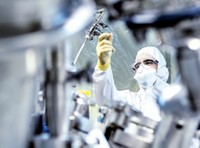Advertisement
Grab your lab coat. Let's get started
Welcome!
Welcome!
Create an account below to get 6 C&EN articles per month, receive newsletters and more - all free.
It seems this is your first time logging in online. Please enter the following information to continue.
As an ACS member you automatically get access to this site. All we need is few more details to create your reading experience.
Not you? Sign in with a different account.
Not you? Sign in with a different account.
ERROR 1
ERROR 1
ERROR 2
ERROR 2
ERROR 2
ERROR 2
ERROR 2
Password and Confirm password must match.
If you have an ACS member number, please enter it here so we can link this account to your membership. (optional)
ERROR 2
ACS values your privacy. By submitting your information, you are gaining access to C&EN and subscribing to our weekly newsletter. We use the information you provide to make your reading experience better, and we will never sell your data to third party members.
Business
Happy Results For A Depression Drug
Case Study #2: Compound nears the market under a new manufacturing partnership
by Michael McCoy
March 12, 2012
| A version of this story appeared in
Volume 90, Issue 11
Fred j. Fleitz and Walter Piskorski both got new jobs in October 2010—Fleitz with a contract manufacturer of pharmaceutical chemicals and Piskorski with a start-up drug company. Less than 18 months later, the two men had successfully collaborated to produce the active ingredient for a promising antidepressant drug candidate under the exacting conditions required by the Food & Drug Administration.
COVER STORY
Happy Results For A Depression Drug
The speed with which they carried out the project is a testimony to the experience they brought to their new jobs. It’s also a sign of the urgency felt by biotech firms and their manufacturing partners to advance drug candidates as far as they can before the funding runs out.
Fleitz is a synthetic organic chemist who earned a Ph.D. at Stanford University under Barry Trost. After graduating in 1996, Fleitz joined Merck & Co.’s process research group in Rahway, N.J., where he was schooled in industrial process chemistry by some of the most experienced chemists in the business.
Joining Merck in what were still the drug industry’s golden years, Fleitz expected to spend most of his career there. But the realities of patent expirations and Wall Street expectations soon intruded. Merck acquired Schering-Plough in 2009. In the summer of 2010, Fleitz, like many Merck scientists, was let go.
During his search for a new job, Fleitz learned about Cambridge Major Laboratories, a pharmaceutical chemical company in Germantown, Wis. While Merck and other big pharma companies were downsizing, Cambridge Major was expanding. It was looking for experienced chemists with the ability to shepherd projects through a new large-scale manufacturing facility. Michael W. Major, the company’s founder, offered Fleitz a job as senior manager for process R&D.
Piskorski, meanwhile, had just joined Euthymics Bioscience as vice president for technical operations. A chemical engineer, Piskorski had enjoyed a long career with big-name companies such as Bristol-Myers, Baxter International, and Sepracor. In his most recent job he had been enjoying something different: helping the California biotech firm Orexigen Therapeutics develop the antiobesity drug Contrave and get it in front of FDA for review.

Then in September 2010, Orexigen signed a commercialization partnership with Takeda Pharmaceutical. “My future role was going to be to make the product and sell it to Takeda, which was not very exciting,” Piskorski recalls. So when Anthony McKinney, a former boss at Orexigen, called him about a job at another start-up, Euthymics, he jumped at the opportunity.
McKinney had launched Euthymics in 2009 along with Frank Bymaster, a former Eli Lilly & Co. scientist who had helped discover and develop the antidepressants Prozac, Cymbalta, and Symbyax. Armed with $24 million from Novartis Venture Funds and other investors, Euthymics acquired the bankrupt DOV Pharmaceutical in July 2010. McKinney and Bymaster set out to revive DOV 21947, an antidepressant that had been in development for patients who do not respond to selective serotonin reuptake inhibitors such as Prozac.
DOV 21947 has a long history. Its racemate and related compounds were discovered in the 1970s by scientists at Lederle Laboratories, which later became part of Wyeth. DOV, formed by former Lederle R&D executives, licensed the compounds from Wyeth in 1998. The company separated the enantiomers and completed four Phase I clinical trials on the one it named DOV 21947. DOV licensed the compound to Merck for $35 million in 2004, but Merck ended the deal and returned the compound in December 2006. The following month, DOV declared bankruptcy.
Although Merck wasn’t impressed with DOV 21947, McKinney and Bymaster saw in the compound, later renamed amitifadine, a potentially effective antidepressant. According to Euthymics, amitifadine inhibits the reuptake of three neurotransmitters—serotonin, norepinephrine, and dopamine—in a ratio that approximates in a single compound the pharmacology of a two-drug combination found to work favorably in a major U.S. government study.
Euthymics inherited some bulk amitifadine left over from DOV’s Phase I trials. Piskorski’s first job upon joining the firm was to find a contractor to manufacture more so the compound could complete Phase II and III studies. The contractor would also be charged with producing EB-1020, a closely related compound being developed as a treatment for attention deficit/hyperactivity disorder.
Piskorski chose Cambridge Major after evaluating three detailed responses to his request for proposals. “I tend to approach picking a development partner from the green back to the tee,” he says. By that Piskorski means he evaluates how the partner would complete the most commercially advanced task—manufacturing thousands of kilograms of the drug—and then walks back to see how it would get to that point, starting with the first laboratory feasibility experiments.
Piskorski liked the game plan that Cambridge Major laid out, and he especially liked Fleitz. “They all had technical competence, but I take that as a minimum,” he says of the Cambridge Major staff. “They also had a business savvy that I almost feel is more valuable.”
That savvy helped the Cambridge Major scientists understand the steps in the manufacturing process that needed to be optimized—as well as those that didn’t—for a customer that had limited resources. “That’s a balancing act, and that’s where Cambridge Major shined,” Piskorski says. “They weren’t scientists that wanted to run 12 experiments to find the ideal mixing speed.”
Digging into the job early last year, Fleitz and his team had the luxury of an existing synthetic route. The earliest medicinal chemistry synthesis of amitifadine was a multistep process that required a separation of enantiomers at the end. But a team of Merck chemists—coincidentally, colleagues of Fleitz’s when he worked there—had developed an elegant asymmetric synthesis during the period that Merck had the compound (Org. Lett., DOI: 10.1021/ol061650w).
In the Merck synthesis, the first reaction step determines enantiomeric excess, so a key goal for Fleitz and his colleagues was to find the right temperature and other conditions to minimize loss of that excess in subsequent reaction steps. They also needed to re-create specifications that Merck may have established but that weren’t in the literature.
At the same time, the Cambridge Major chemists were scaling up the process from the glassware synthesis completed by Merck into one that would work in small stainless steel reactors for clinical-trial quantities and then in larger reactors to yield the hundreds, if not thousands, of kilograms that would be needed for commercialization.
It’s a task that Cambridge Major is well suited for, according to Fleitz. “We have that ability within the same facility, so the chemist that started the project can follow it all the way through,” he says.
By last September, Cambridge Major had produced multiple kilograms of both amitifadine and EB-1020 under the current Good Manufacturing Practice conditions required by FDA for human trials and commercial use. The company had also mapped out what it would need to do if called on to advance the process further—into the 500- or 1,000-gal reactors required for producing hundreds of kilograms.
On the basis of that analysis, Piskorski and Fleitz concluded that Cambridge Major is capable of manufacturing enough amitifadine to meet Euthymics’ commercial needs, even under optimistic demand forecasts, for five years after the product hits the market, which the company hopes will be in 2016. Having that capability will stand Euthymics in good stead in any future negotiations with potential big pharma partners.
Both men hope to continue the partnership through the decade. Of course, that assumes that amitifadine reaches the market as planned. Euthymics is in the midst of a Phase IIb/IIIa clinical trial of the compound as a second-line therapy for major depressive disorder, and it expects to have the results later this year.
“We face the typical binary possibilities for a start-up,” Piskorski says. “If you come by after then, we’ll either be drinking champagne from the water cooler, or you will see a new name on the door.”






Join the conversation
Contact the reporter
Submit a Letter to the Editor for publication
Engage with us on Twitter